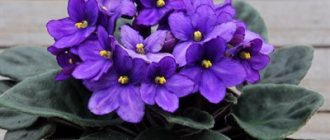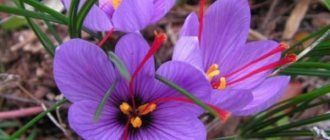When touching crocus flowers flash on the canopy of bright fallen leaves, like small harbingers of spring, it seems as if time has flown backwards. It would be difficult to find a more delicate autumn-flowering plant. Crocuses, opening their flowers at the end of the gardening season, are the closest relatives of everyone's spring favorites. They are grown according to almost the same rules as ordinary crocuses, only these plants bloom not after a long winter, but before it begins.
Saffron or beautiful crocus (Crocus speciosus). © Meneerke bloem
Caring for crocuses in open ground
We will tell you below how to grow crocuses strong and healthy after planting. But know that you won’t spend a lot of effort and a lot of time.
Watering crocuses
There is no need to water saffron regularly; besides, it is very sensitive to stagnation of moisture. Crocuses need a lot of water during the spring and autumn flowering periods. But nature helps us there too: in one case, the snow melts and gives water, in another - autumn rains. Additional watering is organized if the winter was not snowy and the autumn was not rainy enough. But even with insufficient moisture, crocuses successfully go through the growing season. They will only become smaller in height. In summer, during periods of calm, crocuses do not need water; they prefer to rest in a dry environment.
Fertilizer and feeding
The basis for growing all plants in the garden is fertilizing, therefore, when thinking about how to grow healthy and beautiful crocuses in your garden, you need to prepare a complex of mineral fertilizers. Feeding crocuses has some nuances. Fresh organic fertilizers are not allowed. They cause various diseases. Peat, completely decomposed manure and other mineral fertilizers will be preferable.
In early spring, during the period of active growth, you need to sprinkle fertilizer on the melting snow. At the beginning of the vegetative period, urea can be introduced. Later, an excess of nitrogen will cause a sharp growth of leaves, which will provoke the appearance of unwanted fungal diseases in wet weather. After half a month, fertilizers rich in phosphorus and potassium should be added to the planting site. They will contribute to better flowering and the formation of strong and healthy corms.
Care after flowering
Like many bulbous flowers, these flowers lose their leaves by mid-summer, so you need to take special care of the crocuses in your garden after they bloom. If you have no plans to transplant the plant to a new location, then you can get by with removing the wilted foliage. If the decision was made to dig up crocuses, then the best time is July.
The procedure looks like this:
- Remove blooms that have faded so that the plant does not have to put extra effort into trying to form seeds.
- Gradually reduce the amount of watering. So the outflow of all nutrients will gradually go into the corm
- When the leaves turn completely yellow, the bulb needs to be dug up and dried a little at room temperature.
- Next, remove scales and discard diseased and damaged daughter tubers.
- Bulbs should be stored in a well-ventilated area at a temperature within 20 °C.
Transplanting crocuses
Due to the abundant formation of daughter bulbs in crocuses, they need to be planted. Otherwise, a large nest of shoots will form. They become crowded, they become deformed, the flowers become smaller, and the plant loses its aesthetic appeal.
The bulbs should be dug up after the leaves have completely died in mid-July to early August. Store in a warm, well-ventilated area until transplantation. They need to be planted in flower beds in August or September at a distance equal to two to three corm diameters from each other. The hole must be dug to a depth equal to three bulbs in height.
Storing Crocus Bulbs
The extracted corms must be cleaned of soil, dead roots and scales, and then laid out in one layer in a box or box. The smallest ones can be placed, for example, in candy boxes. Until August, planting material should be stored at a temperature of +22 °C and not lower, since it is under this regime that flower buds are formed. In August, the temperature should be lowered to +20 °C. In a week - up to +15 °C. But such conditions are difficult to create at home, and they are ideal, because only in specialized farms can the thermal regime be adjusted. Under our usual conditions, crocus bulbs need to be placed in a dark, dry place with good ventilation and room temperature.
Did you know? To obtain 1 kg of saffron spice, you need to collect about 600,000 stigmas from newly blooming crocus flowers. Hence the expression “as dear as saffron.” A very justified statement.
Growing tender autumn crocuses: subtleties of flower care
Many gardeners are accustomed to the fact that crocuses are delicate and beautiful harbingers of spring. However, crocuses (saffrons) can also be grown in the fall! This is an amazing phenomenon when delicate and neat buds open surrounded by fallen yellow autumn leaves... It is noteworthy that it is not difficult to grow these wonderful flowers and enjoy their enchanting beauty.
Of the autumn crocuses, the following types are considered the best: Banat crocus, beautiful crocus, Sharoyan crocus, pretty crocus, hill (or valley) crocus and Pallas crocus. They bloom after the leaves fall, and this is truly an incredible and enchanting action. Crocuses or crocuses are suitable not only for planting in the garden, but also for growing indoors.
The best place for a crocus to live is considered to be an area protected from wind and drafts. They require dryness and warmth, since excess moisture harms delicate roots and is a common and main cause of rotting. Crocuses prefer light soil, neutral soil. The fertility of the land does not play a big role.
Before planting crocuses, it is advisable to prepare the ground. Poor soil can be amended with manure and leaf soil. Crocuses also love phosphorus-potassium fertilizers and respond to them with gratitude. Fall crocus bulbs are best planted between June and early August. Planting should be done in groups of 5 pieces with a distance of 5-6 cm from each other.
Growing crocuses in the fall is not difficult. They do not even need additional watering, except during periods of drought, during active plant growth. What the flower really needs is phosphorus and potassium. Apply fertilizers to the soil in a timely manner so that the flower develops into a strong and flowering plant that can delight you with beautiful buds.
Crocuses are frost-resistant flowers, so they do not need any preparation for winter. It is only necessary to monitor the soil moisture and avoid excess moisture, as it can lead to rot of the bulbs.
Autumn crocuses reproduce easily. Every year the bulbs form up to 7 daughter bulbs. When digging up the bulb, the daughter tubers should simply be separated and planted as usual. These are very beautiful and delicate flowers that can delight you every year!
Colchicum care
Garden hibiscus - features of growing in open ground
There is nothing difficult in caring for such a plant. Watering should be done only when the plant is blooming, and then this should be done only during periods of prolonged drought and heat. At other times, such a flower should not be watered, because natural precipitation will be enough for it. Remember to avoid over-wetting the soil.
Feeding is done 2 or 3 times per season. To do this, use complex mineral fertilizer (30 grams per 1 square meter), and prepare a weak solution (2 grams of substance per 1 liter of water). Remember that the fertilizer must contain nitrogen. In autumn, compost should be added to the soil. It is also necessary to systematically loosen the soil surface and remove weeds.
How to transplant
This flower can be grown in the same place for quite a long time (about 6–7 years), then it must be transplanted to a new place. However, experienced gardeners advise replanting at least once every 2 or 3 years, otherwise the bulbs will grow and become very crowded, and the flowers will become smaller.
The best time for both planting and replanting such a plant is August. At this time, the crocus is at rest. However, the bulbs must be dug up in advance, after the leaf blades turn yellow, as a rule, this time occurs in the second half of June. You need to carefully remove the soil from the bulbs, and also remove the remaining leaves. Separate the daughter bulbs from the mother bulbs, keeping in mind that the latter are not used for subsequent planting. Then the bulbs should be carefully washed in running water, after which they are placed in a solution of potassium manganese for disinfection for 30 minutes. Then the tubers need to be thoroughly dried and stored in a dry, dark place, while the air temperature should be approximately 24 degrees. With the onset of August, the separated daughter bulbs must be planted in the ground. In this case, the planting rules are exactly the same as those used for planting colchicum (described above). At the same time, do not forget to fertilize the soil first.
Diseases and pests
Snails and slugs can live on such a flower. Such pests feed on its leaves. If the soil is almost constantly waterlogged, this can cause the development of gray rot. In order to avoid the appearance of slugs, the surface of the rows must be covered with a layer of crushed shells, fine gravel or egg shells. You can also place plastic gutters around the perimeter of the site into which you need to pour water. They will become an insurmountable barrier for slugs and snails.
If the crocus is regularly watered abundantly for a long time, gray rot, which is a fungal disease, may appear on it. If the flower is not very infected, you can try to cure it. To do this, it is recommended to treat the bush with Champion, Topaz, Kuproxat or another product with a similar effect. Before treatment, those parts of the plant that are severely affected should be cut off and burned. Then you need to reconsider the watering schedule.
Sorting of planting material
Basically, the requirements for it are the same as for tubers of other bulbous plants.
- Sufficient density. When lightly compressed, the bulb should “spring” a little. If it is too pliable, then most likely it will not survive the period of cold weather in the ground.
- The scales that form the outer shell must be dry. Even their slight moisture is a reason for rejection, as this may indicate the beginning of the process of rotting from the inside.
- This is also true in cases where the tuber has dark inclusions or spots, mechanical damage - such material is not suitable for planting, regardless of the time of year. Darkening is often caused by some kind of disease, which means there is a high risk that the “infection” will spread to other crocuses, since the planting of this flower is quite dense.
- Bulbs with elongated roots or sprouted shoots are also not taken for winter planting in the ground. What is suitable for spring is definitely not for autumn.
Features of crocuses
Greenhouse tomatoes for beginners: features of growing and watering tomatoes in a greenhouse
Continuing to further understand the differences between autumn crocus and colchicum, you should study all the characteristic features of the first plant
When discussing this plant, special attention should be paid to the following points:
- Feeding.
- Landing.
- Watering.
- The soil.
Feeding. The ideal fertilizing option for crocus is mineral fertilizers. This fertilizer can be used even earlier in the spring, or rather, water the plant with it, even if there is still snow on the ground. It is advisable to additionally mulch the soil in which the crocus grows, using peat chips or ordinary fallen leaves. This is necessary for the plant to survive severe frosts during winter. If the crocus bulb did not survive the frost and died, there is no need to throw it away immediately, since the buds that surround it may well give birth to offspring.
Watch a video about what crocuses look like.
Landing. Often, the depth of planting of a crocus is determined depending on the size of its bulb. If the bulb is large, then it needs to be buried 10 centimeters into the ground; if it is medium in size, then 5 centimeters is enough. The gap between the bulbs should be at least ten centimeters. When planting this plant, keep in mind that planting too deeply can significantly slow down vegetative propagation.
Watering. Housewives who grow crocuses must constantly ensure that the soil is always properly moistened. And as soon as sprouts begin to appear from the corms, they need to be systematically watered. But, after a while, you need to water only as needed. Try to let the soil dry out between waterings.
The soil. For a plant to develop well, it needs to grow in fertile soil. If you initially plant your crocus in good soil, then when it blooms, you will not need to use additional fertilizers to stimulate growth. And also we should not forget that many people really like the way the colchicum blooms.
Crocus is also popularly called saffron. It has long been known that saffron is one of the excellent spices for preparing very tasty dishes. But such a spice cannot be collected from ordinary flowers that grow in our flower beds. For culinary purposes, you need to grow a special seed crocus.
Most crocuses bloom in autumn. Autumn varieties of crocuses begin to bloom only in leaf fall. Of course, they cannot please you with their flowering for too long, but even in this short period, these flowers will give you a small piece of summer and warmth. Most often they are used for the following purposes:
- to elegantly decorate the lawn;
- as an interesting accent in small groups of different colors;
- to highlight the color scheme along the edges of flower beds;
- for decorating water bodies.
The uniqueness of this plant also lies in the fact that it can also be grown as an indoor crop. But, you should take into account the fact that as a houseplant, the flowering period will shift. By the way, the flowering period depends on the time of planting the bulb, and not on the natural life cycle.
Description of the colchicum
When choosing an area for planting colchicum, it is best to give preference to a sunny area. This plant will do well in absolutely any soil:
- alkaline;
- sour;
- neutral;
- in clay.
When planting, you should adhere to the following recommendations:
- Before planting, it is appropriate to first dig up the area and add a little humus there.
- When planting a plant, it is advisable to fill the soil generously with superphosphate.
- The distance between the bulbs should be at least 15 centimeters.
When you are looking for an answer to the question whether crocus and crocus are the same thing or not, then first of all you will find information that crocus is a poisonous plant. But don’t think that this is a reason to refuse to plant these extremely beautiful flowers. To protect yourself and your loved ones, just make sure that the flowerbed is not accessible to children and animals. And also when working with such a plant, be sure to wear special gloves. By following these tips for growing colchicums in your flowerbed, you will only get pleasure and can be absolutely calm.
If you don’t know whether it’s better to choose an autumn crocus or a colchicum for your garden, then you can easily choose two options at once. Because their combination has a special charm and sophistication. To understand why Colchicum is poisonous, you can search for such information on the Internet.
In what month should you plant crocuses in the fall?
Approximately, primrose crocus bulbs are placed in the ground from late August to early November. The exact timing of planting depends on the climate of the area in which the flower garden is located and the weather prevailing in a given season.
As a rule, all bulbous flowers (crocuses, muscari, tulips, hyacinths) are planted at the same time.
Plants require about 4-5 weeks of comfortable warm weather to establish successfully.
The time for planting crocuses in open ground in the fall is set a month before the onset of frost, during which the soil freezes to a depth of 10-15 cm.
According to the Lunar calendar
For those gardeners who adhere to the recommendations of the Lunar calendar, in 2022 the favorable days for planting are as follows:
- August: 2-6, 8-10, 22-24, 29-31
- September: 5-7, 13-15, 23-25, 28-30
- October: 2-4, 11-15, 20-22
- November: 21-23, 26, 27
- December: 4-6, 14-16
Unfavorable days:
- August: 11, 12, 27-28
- September: 9-10, 26, 27
- October: 9, 10, 25, 26
- November: 1, 2, 7-9, 24, 25, 28, 29
- December: 7-9, 23-25
When to plant crocuses in the fall in the Moscow region and other regions
In the Moscow region and central Russia, flower bulbs are placed in open ground at the end of September - October. The exact date will be determined by the gardener himself, focusing on the weather in his area. If winter is expected to arrive early, flowers are planted earlier.
In the Leningrad region, crocus is planted in October.
The climatic conditions of the Urals and Siberia are harsh, autumn is short, the first frosts on the soil occur as early as September. There is no need to delay planting perennials; the bulbs are placed in the ground in September.
For the winter, it is recommended to cover bulbous plants with fallen leaves, sawdust, and spruce branches.
In the south of our country, a warm, long autumn allows planting to begin at the end of October. The crop does not need shelter for the winter.
In Ukraine the climate is as mild as in the south of Russia. The timing of planting crocuses is the same as in the Krasnodar Territory and Stavropol Territory - the end of October.
In Belarus, autumn weather varies somewhat depending on the region of the country. In the north, crocuses are planted in the ground at the beginning of October, in the south - at the end of the month.
The gardener is recommended to monitor the weather in his area, recording the timing of cold weather and thaws, droughts and rainy years in a diary. By analyzing records over several years, it is possible to determine the optimal time frame for working with plants in a particular area.
How to plant crocuses in open ground correctly
Features of growing apricot
In order to properly plant crocus corms in open ground in the fall, you need not only to correctly carry out the procedure itself, but also to complete the preparation.
So, in general, the procedure can be divided into several key stages:
- choice of location;
- site and soil preparation;
- preparing bulbs;
- the landing itself.
Each point will be discussed in detail below.
Selection of location and soil
Where is the best place to plant crocuses in your garden? When choosing a place to plant corms, keep in mind that flower culture likes areas that meet the following requirements:
- The soil is fertile and nutritious.
- The soil is well drained, without excessive moisture (excess moisture will cause the bulbs to rot).
- The soil is nutritious sandy loam or loamy.
- The soil has a neutral reaction (pH 6.5-7).
- The place is well lit by the sun.
- The site is protected from strong and cold winds.
Soil preparation
If the soil at your dacha or the site of a private house does not meet the above requirements, then you must take some measures. After all, if crocuses are grown in open ground in optimal conditions for them, then they will undoubtedly delight you with their beautiful and lush flowering.
Preparing a garden plot for planting crocuses in the fall is carried out according to the following scheme:
- Using a shovel, you need to dig up the area where you plan to plant the bulbs. However, if the soil needs to be improved, then before digging you need to add certain substances to the site depending on the problem (if the soil is ideal, then you can just dig): For heavy, clay soil, you need to put sand on the soil (1 bucket per square meter) and compost or humus (1 bucket per sq.m.).
- If the soil is too light, sandy, you need to add compost/or humus (1 bucket per sq.m.) and preferably lowland peat or leaf humus (the same amount).
- For depleted, infertile soil, it is recommended to add organic fertilizers - compost or humus (1-1.5 buckets per sq.m.), as well as mineral fertilizers - superphosphate (40 grams per sq.m.).
Preparing Crocus Corms
Before planting in open ground, it is recommended to prepare crocus corms. Pre-planting treatment helps eliminate pathogens of dangerous diseases from planting material, which will prevent the development of the disease, and will also serve as an excellent disease prevention.
To treat crocus bulbs, it is recommended to soak them in a fungicide solution, for example, “Fundazol”, “Maxim Dachanik”, “Vitaros”.
It is also useful to soak in a solution of a growth stimulator; such preparation will increase the immunity of the bulbs. For example, it can be treated in Epin-Extra or Zircon solution.
There is no need to remove the covering scales from the bulbs. The exception is the scales, which almost fall off on their own; they can be carefully removed.
Planting scheme
So, if you have completed the preparation of the site and material, it’s time to get down to business. Standard scheme for planting crocus bulbs in open ground in the fall:
- Make holes in the prepared area. At what depth and at what distance should the onions be planted? the distance between the holes is 3-5 centimeters from each other (such a small gap is due to the fact that crocuses feel good in joint “family” plantings);
- the depth of the holes is 3 times the height of the crocus bulb (that is, if the height of the corm is 2 centimeters, then you need to multiply 2 × 3, it turns out 6 - this is the planting depth).
Place a small handful of sand on the bottom (this is especially important if moisture stagnation or waterlogging is possible). Place the bulbs bottom down, it should stand straight. Fill the hole with soil. Lightly compact with soil. Water. Mulch the flower garden.
When to plant crocuses - autumn or spring?
All crocus plants are divided into two groups according to flowering time: primroses (buds open in early spring) and late-season bloomers (you can admire the flowers in August - September).
When to plant crocuses in open ground - in autumn, spring or summer, depending on the variety:
Blooming in spring
Spring flowers wake up very early, as soon as the snow cover melts. Leaves appear from the ground first, then a flower arrow with buds. After flowering, the above-ground part of the crocus dies and the plant enters a dormant stage until the next season.
This group of flowers is planted in the fall, when the plant is dormant. Spring crocuses are the most common among gardeners.
Blooming in autumn
Less common in our country are crocuses that bloom in autumn. Due to the short warm period in most regions of our country, autumn crocuses often go under the snow while still blooming, without having time to show themselves in all their glory.
These plants are planted during the summer so that by August they have time to take root and send out flower shoots.
When purchasing crocus planting material, the gardener needs to make sure which group the plant bulbs belong to. Autumn specimens planted in September will not have time to form correctly and may die in winter.
Rules for growing and care
When to plant Colchicum
Corms are planted in sun or partial shade in August. The bulbs are buried to 3/4 of the height of the bulb. Plants prefer loamy soil and can grow in one place for many years.
Colchicum care
In spring and autumn, if there is no rain for a long time, watering will not hurt. In summer, watering is not required. In spring and autumn, if desired, you can feed the plants with Ntroamophoska 40 - 50 g/sq m. But simple, unpretentious varieties, as a rule, do without this, develop and bloom well.
To protect against freezing, non-resistant varieties, including white-flowered and terry ones, for the winter it is advisable to mulch them with a layer of humus, cover them with leaves or spruce branches.
It is important to remember that in spring Colchicum wakes up very early, so you should remove mulch, foliage or spruce branches in time
How to store crocuses before planting in the fall
How and where to store crocus corms before planting in the ground? After all, three months must pass from the moment they are removed from the soil until autumn planting. Corms disinfected with potassium permanganate and dried are laid out in one layer in a wooden box and stored in a room with a temperature of at least 22 ºC until August. From the beginning of August, it is advisable to lower the temperature to 20 ºC, and closer to September - to 15 ºC.
It is in these conditions that Dutch professionals store crocus corms, but since it is difficult for amateur gardeners to organize such conditions, the planting material is stored until autumn at room temperature.
Autumn-blooming corms are planted in the garden in August, and spring-blooming crocuses - from September.
Seeds, bulb, flower
A large box with seeds, covered in the middle of a bunch of leaves, will appear simultaneously with them only next year.
An interesting feature of this plant is its “peduncle”, because it is not a stem at all, as it seems at first glance, but a highly elongated flower tube into which all six of its petals grow together. The ovary itself is located inside the corm, which is hidden underground.
This is what allows the germinating seeds to safely overwinter and continue development in the new season.
The most interesting feature of Colchicums is that they always bloom unexpectedly. So even if you have been cultivating this plant for several years and are not going to be surprised by the sight of “naked” flowers without leaves, their appearance will still take you by surprise, because they are unpredictable.
As if by magic, lilac, blue or white buds appear from the ground overnight. The leaves that grew in the spring dry up by July and over the summer you can simply forget that anything grew here.
The best varieties for planting in autumn
All varieties of crocuses can be divided into autumn and spring, that is, those that bloom in autumn and those that bloom in spring. In garden culture, only large-flowered and botanical species of spring crocuses are predominantly used; autumn ones are much less common.
Botanical
They are distinguished by abundant flowering and pleasantly smelling flowers. They reach a height of no more than 8 cm. They bloom, one can tell right from the snow. Among them are the following varieties:
- Blue Pearl . Characterized by flowers of a soft blue hue. Flowering begins very early, usually it is massive and friendly.
- Prince Claus. The coloring of this variety is very original. Against the background of white petals, a purple stripe stands out very clearly. It usually blooms early and quite abundantly.
- Cream Beauty. Pale yellow flowers with bright yellow stigmas. It has very abundant flowering.
- Princess Beatrix. The flowers are blue with a yellow bottom.
Large-flowered
The most common and famous group of crocuses. It differs from the others in its larger flowers and later flowering. Almost all large-flowered crocuses are Dutch hybrids, obtained by crossing different species. They are characterized by a very wide variety of colors.
They bloom about a week later than botanical varieties, somewhere in the second half of April. Often the timing of flowering depends on the weather conditions of a particular year. Below are the best varieties of large-flowered crocuses:
- Joan of Arc. It is the best variety of white crocuses. The flowers are pure white flowers with a lilac bottom, their height is no more than 4 cm. The flowering period occurs in the second half of April.
- Pickwick. It has a very original coloring of flowers. There are lilac strokes on a pure white background. Due to its unusual color it is a very popular variety.
- Flower Record. The flowers are about 4cm high, deep purple with a darker base. It blooms at the end of April and can be used for group plantings and when creating a rock garden.
Varieties of autumn crocuses
The flowering period of these crocuses falls in autumn, but depending on the region it can last until December. In this group, only leaves grow in the spring, and flower stalks appear in the fall after they die. The most common varieties are:
- The crocus is wonderful. It is the earliest of this group, blooming in early autumn. Its flowers have quite a variety of colors; you can find white, purple, and blue inflorescences. Valued for its absolute unpretentiousness.
- Crocus zonatus. It blooms from the second half of September or October. The flowers are deep pink with a yellow center. The flowers are about 4 cm in height. The inflorescences of this variety are characterized by a slight sweetish smell.
- Crocus pale ocher. It has rather small milky inflorescences and is unpretentious.
- Long-flowered crocus. A late-flowering variety, its flowering period occurs in November.
Caring for crocuses in open ground - growing rules
Crocuses do not require special care, so they can be called fairly unpretentious flowers. However, to make them look neater and bloom profusely, they still need some gardening manipulations, namely:
- if necessary, loosening and weeding from weeds (in early spring and after flowering);
- moderate watering;
- timely feeding.
In the spring, crocuses practically do not need watering, but after they bloom, closer to summer, if the weather is dry, then at least once a week they should be slightly moistened (especially if the soil is too sandy), but not Do not overwater in any case, so that the tubers do not rot. If the autumn is dry, it will be great to carry out a couple of moderate waterings.
Timely application of mineral fertilizers can contribute to more productive development of plants.
Every year it is best to fertilize crocuses 2 times:
- In early spring there is still snow, that is, before the start of the growing season, it is necessary to use nitrogen fertilizers, such as urea (carbamide) or ammonium nitrate, or better yet, complex nitrogen-phosphorus fertilizers, such as nitrophoska.
- Before or after flowering, it is reasonable to fertilize the plant with any complex potassium-phosphorus fertilizer, for example, superphosphate (preferably double) or potassium monophosphate; it is also good to feed it with ash (just sprinkle in a circle).
Planting crocuses in the ground before winter
Soil for crocuses
For crocuses, you need to select a place in the garden that is protected from the wind and well lit by the sun, where snow does not accumulate in winter - crocuses do not need excess moisture and liquid dirt in the roots. They develop best in light, well-drained and well-fertilized soil.
Autumn planting of crocuses is preceded by cultivating the site: to enhance air and water permeability, two weeks before the scheduled date, the soil is dug to a depth of 20-25 cm with humus and river sand, and light soil with compost. Under heavy clay soils, it is necessary to lay a drainage layer of fine gravel or expanded clay to a depth of 20 cm from the surface. There is no need to apply mineral fertilizers.
At what depth to plant crocuses?
Before planting crocuses, you need to determine to what depth to immerse the bulbs in the soil. As with all bulbous flowers, planting depth depends on the composition of the soil and the size of the planting material - the larger the bulb, the deeper the planting hole should be. Large bulbs are planted to a depth of 8-10 cm when grown in light soils and 7-9 cm when grown in heavy soils, and children - 4-5 cm in sandy soil and 3-4 cm in clay soil.
Planting too deeply slows down the development of the crocus, but promotes the formation of large bulbs. Sometimes young plants form retracting roots and go deeper on their own.
The depth of planting regulates the growth of crocus nests: when the corm is buried 5 cm, you can get up to 10 children; with deeper planting, there will be fewer children, but the flowering of the crocus will last longer and the nest will need to be divided less often - once every 4-5 years.
How to plant crocuses in autumn
Make holes of the depth you need at a distance of 6-10 cm from each other, but if you want to create a thicker mat, the distance between the bulbs can be 3-5 cm. However, please note that the corms quickly become overgrown with children even with such a dense arrangement of the bulbs you will soon have to plant crocuses in the ground. After planting, crocuses are watered, but only if you planted them in dry soil.
Features of planting autumn crocuses
Before planting crocuses, you need to prepare a site for them. Mix sand or fine gravel into the soil to improve drainage, and add mature manure and leaf soil to poor soil. Autumn crocuses will also respond with gratitude to the application of phosphorus-potassium fertilizers (instead of nitrophoska it is better to use superphosphate and potassium nitrate). It is better not to use peat or slak it with lime. In those areas where there is a high risk of getting wet, make raised ridges or lay drainage at a depth of 30-40 cm.
Autumn-flowering crocuses require a slightly different approach to planting: if spring ones are planted in August-September, then autumn-flowering ones need to be purchased before flowering, which traditionally begins in September. The best time for them is from June to the end of the first ten days of August. Do not buy flowering bulbs - they will be weakened and will require several years to recover. Before planting, inspect the bulbs again: they should be heavy, with dense shells, not crushed and soft, with a clearly visible renewal bud (small tubercle). Autumn-blooming crocuses should "wake up" soon, and if buds are not visible on them, it is better not to plant them at all, or plant them in a pot and watch for signs of growth.
Autumn crocuses are planted only in groups of 5 or more, placing the plants at a distance of 5-6 cm between plants. Crocus bulbs are planted at a traditional depth equal to twice the height of the bulbs themselves (from 5 to 15 cm). On heavy soil, leave a distance from the top of the bulb to the edge of the soil equal to the height of the bulb.
It is not necessary to strictly monitor the centimeters: crocuses, unlike many bulbous ones, form retracting roots and the young bulbs themselves will settle in the soil at a comfortable depth. After planting, mulch the soil with sand to protect against slugs. Be sure to mark the planting location with sticks or other markers.
Reproduction
Autumn crocuses are propagated by seeds and division of the corm. Seeds are sown immediately after collection. Seeds left for next spring will germinate for a year, or maybe longer. Crocuses grown from seeds will bloom only after 5-6 years.
To propagate by corms, they should be dug up after 3..4 years, in the middle or end of June, when the leaves of the plants turn yellow. The corms are divided and immediately planted in the soil or stored in a ventilated and dry place (18-20°C).
Conditions favorable for autumn crocuses
Autumn crocuses are much more flexible in their light requirements. Sharoyan and valley crocus love shade or partial shade, but other species are better provided with diffused lighting, sunny and bright places, or at least a semi-shaded location. For autumn crocuses, a growing strategy with a sunny location in spring and autumn and a shaded location in summer is suitable.
Crocuses do not like winds and drafts, so protected areas are chosen for them. The thing is that the flowers of these plants are sensitive to cold autumn winds, and the more protection their “neighbors” provide them, the better.
The location for planting autumn crocuses must be selected so that during the dormant period they do not suffer from getting wet and grow in dryness and warmth. That is why you need to choose either elevated, well-drained places (for example, on alpine hills and rockeries). Another option is to lay drainage during planting.
Pay attention to the soil too. For crocuses, choose light, loamy soils that drain water well
The only exception is the Dutch varieties and hybrids, which tolerate even heavy soil. Be sure to make sure that the soil is neither acidic nor alkaline: crocuses love neutral soils. But they are not so demanding when it comes to fertility: the richest soils and rather poor soils are suitable for crocuses.
Autumn crocuses - photos and use in the landscape
- Due to the fact that the crop is low-growing, crocuses are often used to decorate borders, alpine slides and patterns in flower beds. Autumn crocuses will look very unusual among the yellow foliage of the trees. Therefore, they can be planted simply on the lawn in the garden.
- The beginning of flowering depends not only on the variety of crocuses, but also on the choice of planting site. So in southern flower beds with plenty of sunlight, the plant will bloom 2-3 weeks earlier than in areas in the shade, under trees in the northern part of the garden plot.
- Autumn solo crocuses look no less attractive. This way you can plant flowers of the same color or create a pattern from them. In addition, by combining varieties of different heights, you will get a separate bed of autumn crocuses.
- If you are planting autumn crocuses on the lawn, the first mowing in the spring should be done as late as possible. Since most bulbs of late varieties ripen in the spring with the appearance of leaves. You must give them time to form fruit so that the plant can produce a bud in the fall.
- The delicate flowers of autumn saffron attract with their beauty and abundance of bright colors, as evidenced by the photos.
Features of Colchicum
Such a herbaceous plant is a perennial, and it is also an ephemeral. It has a large number of short shoots, on which large lanceolate-elongated leaf plates are located. They grow and develop during the spring, and by the beginning of the summer period they completely die off. On the surface of the corms there is a brown shell. This shell forms a long tube that covers the lower part of the flower. Most species of colchicum bloom in spring. However, in some species flowering occurs in the spring. Single funnel-shaped flowers grow from the soil. The length of such a flower, together with the perianth fused into a tube (most of it is located under the surface of the soil), is 20 centimeters. The fruit is a three-locular oval spherical capsule. This plant contains poison; Dioscorides himself mentioned this in his works. It should be remembered that the poison is found in any part of this plant.
What you need to know about crocuses
Crocus (second name “saffron”) is a low, bulbous flower that belongs to the large Iris family. Crocus bushes are small and, depending on the variety, reach a height of up to 12-13 cm. Crocuses are loved because they are one of the most attractive and delicate primroses and do not stop blooming, even if the last March snow covers them.
Not all lovers of this flower are aware that there are many varieties of saffron that bloom in the fall, when most garden flowers have already lost their attractiveness, and the garden is waiting for the approach of winter.
If you pay attention to the photo of autumn crocus flowers, it will become obvious that they go well with evergreen ground cover plants. Such autumn flower beds will become a symbol of the continuation of summer in every garden.
Crocuses are flowers that grow in open soil, but like other bulbous flowers, they can be forced to create a delicate flowering bush on your windowsill in the winter season.
Crocus inflorescences open during daylight hours, and at night they turn into small closed buds reminiscent of tulips. Depending on the variety, the inflorescences are yellow, blue, purple or white. Two-color inflorescences, the petals of which consist of purple and white stripes, look very attractive.
The bulbs of young crocuses have a rounded appearance, while older bulbs are flattened and reach a diameter of 3 cm. When dry, the bulbs are covered with scales. Saffron bulbs are said to be edible. But, of course, no one eats them.
But the most valuable and expensive part of the inflorescence is its middle, the so-called stigma with stamens. This part of the flower is a valuable medicine, a natural dye and a well-known aromatic seasoning.
Caring for autumn-blooming crocuses
Offering a taste of spring blooms in an atypical season, these small plants are easy to grow. Crocuses do not need watering, except for the coincidence of winters with little snow and extreme droughts in the spring, when during the period of active growth of autumn crocus foliage it is necessary to replenish the moisture needs of the bulbs and water the crocuses at least several times. Plants do not need watering in the fall.
During the entire phase of active development at the beginning of the season, crocuses need potassium and phosphorus. They can be fed once in early spring.
Apply nitrogen to fall crocuses with caution: vigorous green growth can be detrimental to late-season blooms. In autumn, fertilizers for crocuses are not applied.
What to do with crocuses after planting: care rules in autumn
This flower culture cannot be called whimsical. She is quite undemanding in terms of care, so you don’t need to worry too much in the autumn after the procedure.
However, in order for the bulbs to begin to grow successfully in the open ground in the spring and bloom at the right time, you need to properly care for the crocuses after autumn planting:
- As mentioned above, immediately after the procedure you need to water. You will need approximately 3-4 buckets of water per 1 square meter.
- After the water is completely absorbed, you must mulch the area with flowers. Mulching material will protect the bulbs from cold and frost in winter, and in autumn it will slow down the evaporation of moisture. For mulch, you can use, for example, spruce branches, lowland peat, rotted sawdust, and fallen leaves.
- Mark the future flower garden somehow so that in the spring you don’t accidentally damage the young shoots. For example, you can put up pegs or mark boundaries with stones.
These are the simple rules for caring for crocuses after planting in the fall. The remaining activities should be carried out in the next season in spring and summer.











